Social Determinants of Health: Behavior Change for Public Health
VerifiedAdded on 2023/06/09
|7
|2067
|216
Essay
AI Summary
This essay examines the role of behavior change in public health, focusing on its strengths and weaknesses. It defines behavior change as efforts to alter personal habits for disease prevention, highlighting strategies like motivational interviewing and social support. While the approach encourages healthy behaviors and personal responsibility, it also faces challenges such as reliance on individual willingness and the influence of social and environmental factors. The essay further discusses the application of social marketing and health promotion campaigns, citing examples like efforts to reduce domestic violence and combat HIV/AIDS through campaigns like "Act Against AIDS." The conclusion emphasizes the importance of public health in improving community well-being and acknowledges the complexities of implementing behavior change strategies for positive health outcomes.
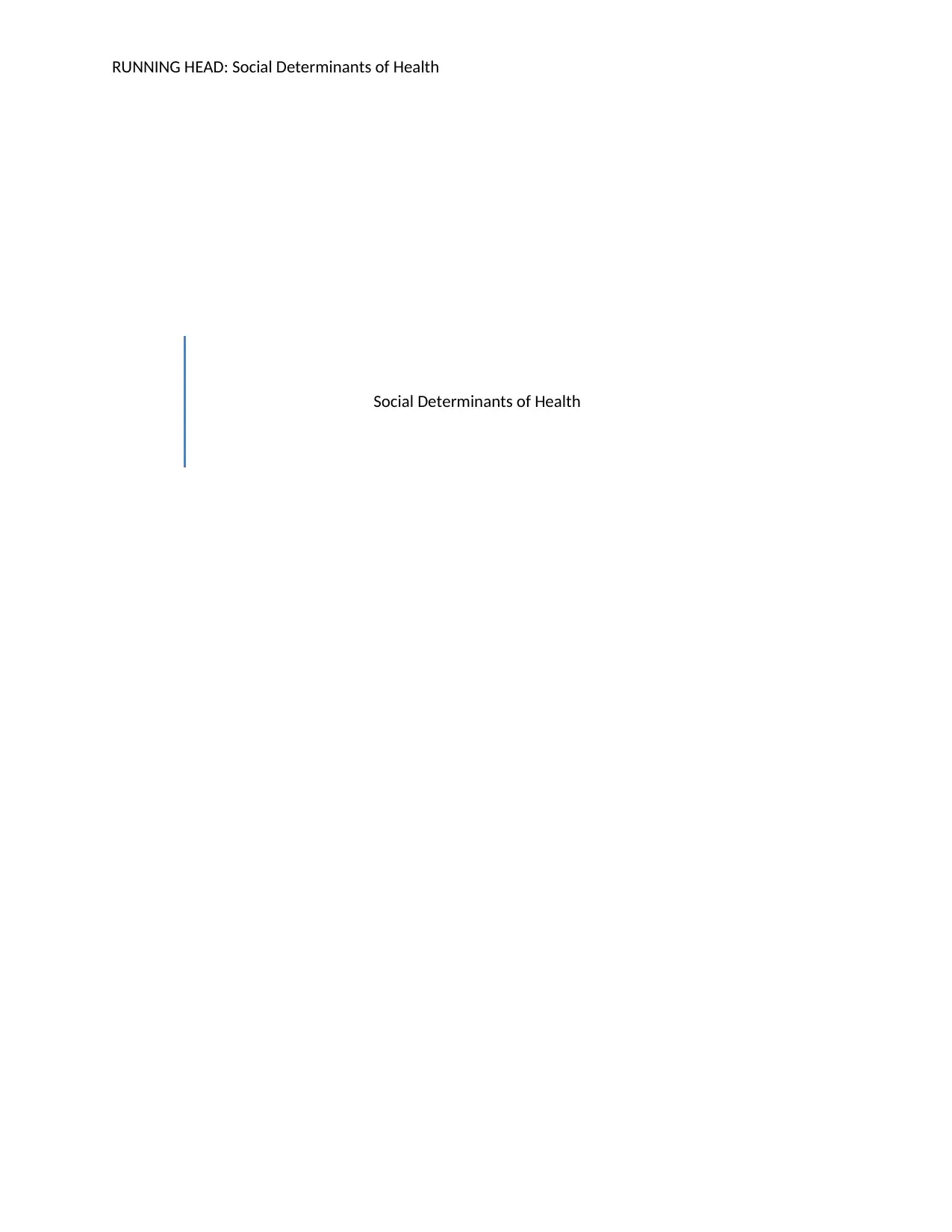
RUNNING HEAD: Social Determinants of Health
Social Determinants of Health
Social Determinants of Health
Paraphrase This Document
Need a fresh take? Get an instant paraphrase of this document with our AI Paraphraser
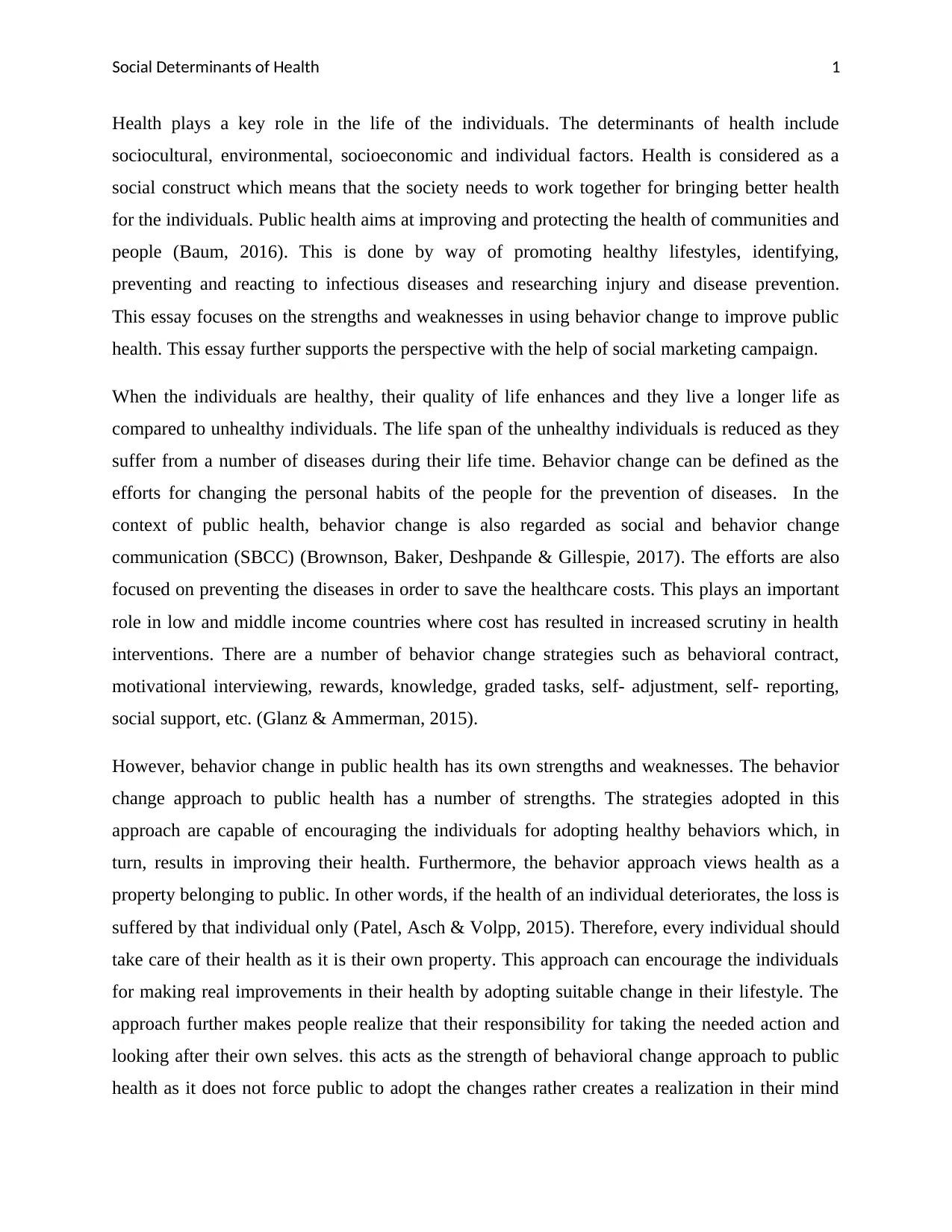
Social Determinants of Health 1
Health plays a key role in the life of the individuals. The determinants of health include
sociocultural, environmental, socioeconomic and individual factors. Health is considered as a
social construct which means that the society needs to work together for bringing better health
for the individuals. Public health aims at improving and protecting the health of communities and
people (Baum, 2016). This is done by way of promoting healthy lifestyles, identifying,
preventing and reacting to infectious diseases and researching injury and disease prevention.
This essay focuses on the strengths and weaknesses in using behavior change to improve public
health. This essay further supports the perspective with the help of social marketing campaign.
When the individuals are healthy, their quality of life enhances and they live a longer life as
compared to unhealthy individuals. The life span of the unhealthy individuals is reduced as they
suffer from a number of diseases during their life time. Behavior change can be defined as the
efforts for changing the personal habits of the people for the prevention of diseases. In the
context of public health, behavior change is also regarded as social and behavior change
communication (SBCC) (Brownson, Baker, Deshpande & Gillespie, 2017). The efforts are also
focused on preventing the diseases in order to save the healthcare costs. This plays an important
role in low and middle income countries where cost has resulted in increased scrutiny in health
interventions. There are a number of behavior change strategies such as behavioral contract,
motivational interviewing, rewards, knowledge, graded tasks, self- adjustment, self- reporting,
social support, etc. (Glanz & Ammerman, 2015).
However, behavior change in public health has its own strengths and weaknesses. The behavior
change approach to public health has a number of strengths. The strategies adopted in this
approach are capable of encouraging the individuals for adopting healthy behaviors which, in
turn, results in improving their health. Furthermore, the behavior approach views health as a
property belonging to public. In other words, if the health of an individual deteriorates, the loss is
suffered by that individual only (Patel, Asch & Volpp, 2015). Therefore, every individual should
take care of their health as it is their own property. This approach can encourage the individuals
for making real improvements in their health by adopting suitable change in their lifestyle. The
approach further makes people realize that their responsibility for taking the needed action and
looking after their own selves. this acts as the strength of behavioral change approach to public
health as it does not force public to adopt the changes rather creates a realization in their mind
Health plays a key role in the life of the individuals. The determinants of health include
sociocultural, environmental, socioeconomic and individual factors. Health is considered as a
social construct which means that the society needs to work together for bringing better health
for the individuals. Public health aims at improving and protecting the health of communities and
people (Baum, 2016). This is done by way of promoting healthy lifestyles, identifying,
preventing and reacting to infectious diseases and researching injury and disease prevention.
This essay focuses on the strengths and weaknesses in using behavior change to improve public
health. This essay further supports the perspective with the help of social marketing campaign.
When the individuals are healthy, their quality of life enhances and they live a longer life as
compared to unhealthy individuals. The life span of the unhealthy individuals is reduced as they
suffer from a number of diseases during their life time. Behavior change can be defined as the
efforts for changing the personal habits of the people for the prevention of diseases. In the
context of public health, behavior change is also regarded as social and behavior change
communication (SBCC) (Brownson, Baker, Deshpande & Gillespie, 2017). The efforts are also
focused on preventing the diseases in order to save the healthcare costs. This plays an important
role in low and middle income countries where cost has resulted in increased scrutiny in health
interventions. There are a number of behavior change strategies such as behavioral contract,
motivational interviewing, rewards, knowledge, graded tasks, self- adjustment, self- reporting,
social support, etc. (Glanz & Ammerman, 2015).
However, behavior change in public health has its own strengths and weaknesses. The behavior
change approach to public health has a number of strengths. The strategies adopted in this
approach are capable of encouraging the individuals for adopting healthy behaviors which, in
turn, results in improving their health. Furthermore, the behavior approach views health as a
property belonging to public. In other words, if the health of an individual deteriorates, the loss is
suffered by that individual only (Patel, Asch & Volpp, 2015). Therefore, every individual should
take care of their health as it is their own property. This approach can encourage the individuals
for making real improvements in their health by adopting suitable change in their lifestyle. The
approach further makes people realize that their responsibility for taking the needed action and
looking after their own selves. this acts as the strength of behavioral change approach to public
health as it does not force public to adopt the changes rather creates a realization in their mind
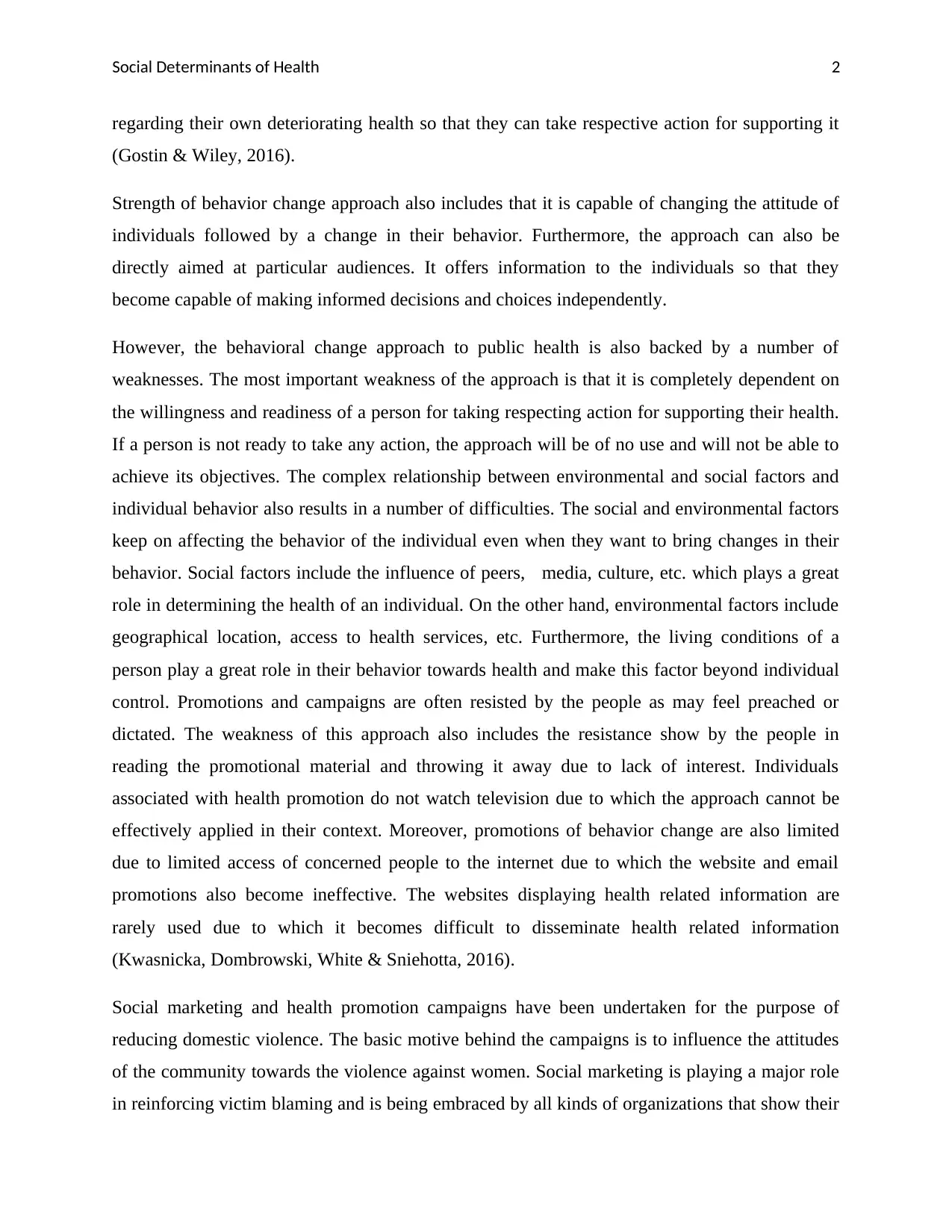
Social Determinants of Health 2
regarding their own deteriorating health so that they can take respective action for supporting it
(Gostin & Wiley, 2016).
Strength of behavior change approach also includes that it is capable of changing the attitude of
individuals followed by a change in their behavior. Furthermore, the approach can also be
directly aimed at particular audiences. It offers information to the individuals so that they
become capable of making informed decisions and choices independently.
However, the behavioral change approach to public health is also backed by a number of
weaknesses. The most important weakness of the approach is that it is completely dependent on
the willingness and readiness of a person for taking respecting action for supporting their health.
If a person is not ready to take any action, the approach will be of no use and will not be able to
achieve its objectives. The complex relationship between environmental and social factors and
individual behavior also results in a number of difficulties. The social and environmental factors
keep on affecting the behavior of the individual even when they want to bring changes in their
behavior. Social factors include the influence of peers, media, culture, etc. which plays a great
role in determining the health of an individual. On the other hand, environmental factors include
geographical location, access to health services, etc. Furthermore, the living conditions of a
person play a great role in their behavior towards health and make this factor beyond individual
control. Promotions and campaigns are often resisted by the people as may feel preached or
dictated. The weakness of this approach also includes the resistance show by the people in
reading the promotional material and throwing it away due to lack of interest. Individuals
associated with health promotion do not watch television due to which the approach cannot be
effectively applied in their context. Moreover, promotions of behavior change are also limited
due to limited access of concerned people to the internet due to which the website and email
promotions also become ineffective. The websites displaying health related information are
rarely used due to which it becomes difficult to disseminate health related information
(Kwasnicka, Dombrowski, White & Sniehotta, 2016).
Social marketing and health promotion campaigns have been undertaken for the purpose of
reducing domestic violence. The basic motive behind the campaigns is to influence the attitudes
of the community towards the violence against women. Social marketing is playing a major role
in reinforcing victim blaming and is being embraced by all kinds of organizations that show their
regarding their own deteriorating health so that they can take respective action for supporting it
(Gostin & Wiley, 2016).
Strength of behavior change approach also includes that it is capable of changing the attitude of
individuals followed by a change in their behavior. Furthermore, the approach can also be
directly aimed at particular audiences. It offers information to the individuals so that they
become capable of making informed decisions and choices independently.
However, the behavioral change approach to public health is also backed by a number of
weaknesses. The most important weakness of the approach is that it is completely dependent on
the willingness and readiness of a person for taking respecting action for supporting their health.
If a person is not ready to take any action, the approach will be of no use and will not be able to
achieve its objectives. The complex relationship between environmental and social factors and
individual behavior also results in a number of difficulties. The social and environmental factors
keep on affecting the behavior of the individual even when they want to bring changes in their
behavior. Social factors include the influence of peers, media, culture, etc. which plays a great
role in determining the health of an individual. On the other hand, environmental factors include
geographical location, access to health services, etc. Furthermore, the living conditions of a
person play a great role in their behavior towards health and make this factor beyond individual
control. Promotions and campaigns are often resisted by the people as may feel preached or
dictated. The weakness of this approach also includes the resistance show by the people in
reading the promotional material and throwing it away due to lack of interest. Individuals
associated with health promotion do not watch television due to which the approach cannot be
effectively applied in their context. Moreover, promotions of behavior change are also limited
due to limited access of concerned people to the internet due to which the website and email
promotions also become ineffective. The websites displaying health related information are
rarely used due to which it becomes difficult to disseminate health related information
(Kwasnicka, Dombrowski, White & Sniehotta, 2016).
Social marketing and health promotion campaigns have been undertaken for the purpose of
reducing domestic violence. The basic motive behind the campaigns is to influence the attitudes
of the community towards the violence against women. Social marketing is playing a major role
in reinforcing victim blaming and is being embraced by all kinds of organizations that show their
⊘ This is a preview!⊘
Do you want full access?
Subscribe today to unlock all pages.

Trusted by 1+ million students worldwide
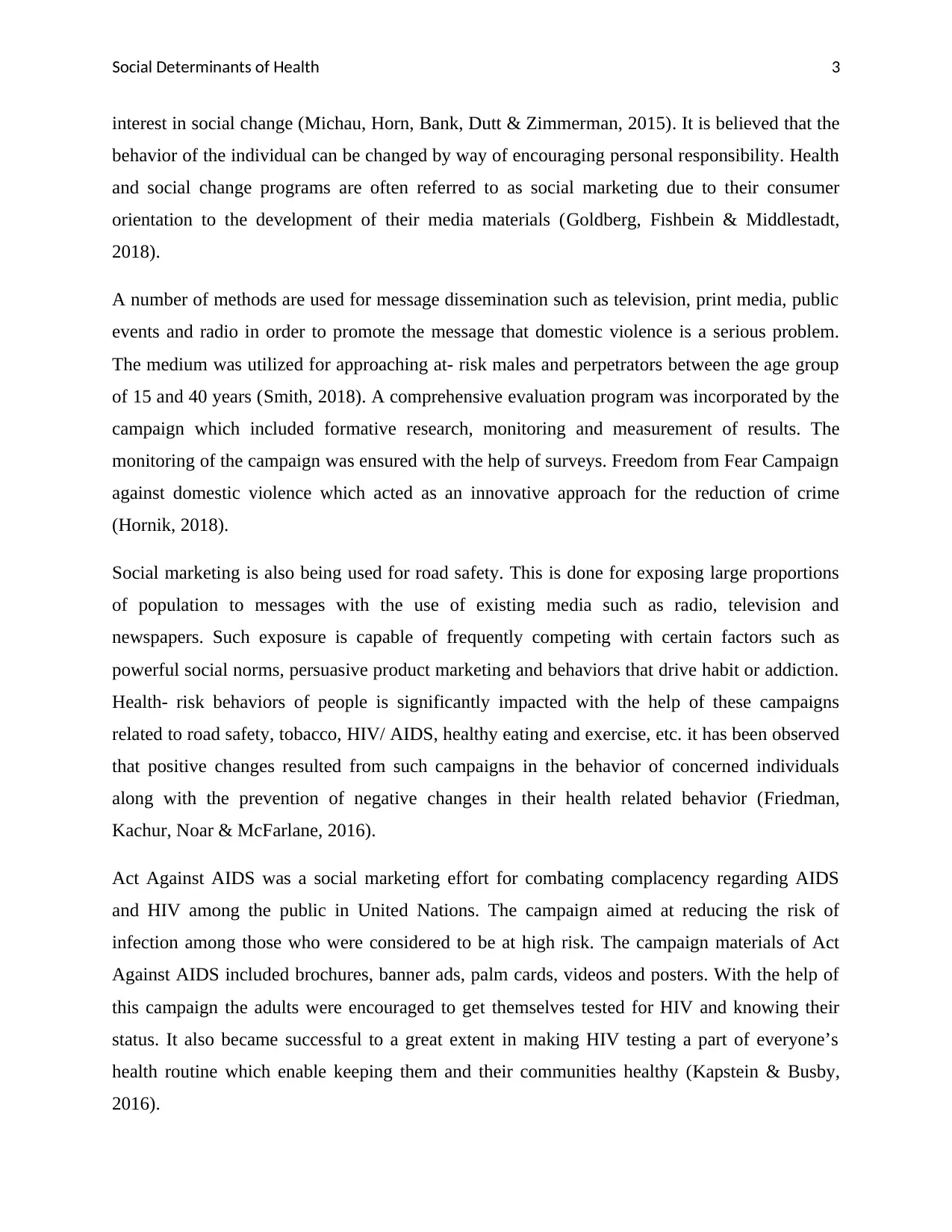
Social Determinants of Health 3
interest in social change (Michau, Horn, Bank, Dutt & Zimmerman, 2015). It is believed that the
behavior of the individual can be changed by way of encouraging personal responsibility. Health
and social change programs are often referred to as social marketing due to their consumer
orientation to the development of their media materials (Goldberg, Fishbein & Middlestadt,
2018).
A number of methods are used for message dissemination such as television, print media, public
events and radio in order to promote the message that domestic violence is a serious problem.
The medium was utilized for approaching at- risk males and perpetrators between the age group
of 15 and 40 years (Smith, 2018). A comprehensive evaluation program was incorporated by the
campaign which included formative research, monitoring and measurement of results. The
monitoring of the campaign was ensured with the help of surveys. Freedom from Fear Campaign
against domestic violence which acted as an innovative approach for the reduction of crime
(Hornik, 2018).
Social marketing is also being used for road safety. This is done for exposing large proportions
of population to messages with the use of existing media such as radio, television and
newspapers. Such exposure is capable of frequently competing with certain factors such as
powerful social norms, persuasive product marketing and behaviors that drive habit or addiction.
Health- risk behaviors of people is significantly impacted with the help of these campaigns
related to road safety, tobacco, HIV/ AIDS, healthy eating and exercise, etc. it has been observed
that positive changes resulted from such campaigns in the behavior of concerned individuals
along with the prevention of negative changes in their health related behavior (Friedman,
Kachur, Noar & McFarlane, 2016).
Act Against AIDS was a social marketing effort for combating complacency regarding AIDS
and HIV among the public in United Nations. The campaign aimed at reducing the risk of
infection among those who were considered to be at high risk. The campaign materials of Act
Against AIDS included brochures, banner ads, palm cards, videos and posters. With the help of
this campaign the adults were encouraged to get themselves tested for HIV and knowing their
status. It also became successful to a great extent in making HIV testing a part of everyone’s
health routine which enable keeping them and their communities healthy (Kapstein & Busby,
2016).
interest in social change (Michau, Horn, Bank, Dutt & Zimmerman, 2015). It is believed that the
behavior of the individual can be changed by way of encouraging personal responsibility. Health
and social change programs are often referred to as social marketing due to their consumer
orientation to the development of their media materials (Goldberg, Fishbein & Middlestadt,
2018).
A number of methods are used for message dissemination such as television, print media, public
events and radio in order to promote the message that domestic violence is a serious problem.
The medium was utilized for approaching at- risk males and perpetrators between the age group
of 15 and 40 years (Smith, 2018). A comprehensive evaluation program was incorporated by the
campaign which included formative research, monitoring and measurement of results. The
monitoring of the campaign was ensured with the help of surveys. Freedom from Fear Campaign
against domestic violence which acted as an innovative approach for the reduction of crime
(Hornik, 2018).
Social marketing is also being used for road safety. This is done for exposing large proportions
of population to messages with the use of existing media such as radio, television and
newspapers. Such exposure is capable of frequently competing with certain factors such as
powerful social norms, persuasive product marketing and behaviors that drive habit or addiction.
Health- risk behaviors of people is significantly impacted with the help of these campaigns
related to road safety, tobacco, HIV/ AIDS, healthy eating and exercise, etc. it has been observed
that positive changes resulted from such campaigns in the behavior of concerned individuals
along with the prevention of negative changes in their health related behavior (Friedman,
Kachur, Noar & McFarlane, 2016).
Act Against AIDS was a social marketing effort for combating complacency regarding AIDS
and HIV among the public in United Nations. The campaign aimed at reducing the risk of
infection among those who were considered to be at high risk. The campaign materials of Act
Against AIDS included brochures, banner ads, palm cards, videos and posters. With the help of
this campaign the adults were encouraged to get themselves tested for HIV and knowing their
status. It also became successful to a great extent in making HIV testing a part of everyone’s
health routine which enable keeping them and their communities healthy (Kapstein & Busby,
2016).
Paraphrase This Document
Need a fresh take? Get an instant paraphrase of this document with our AI Paraphraser
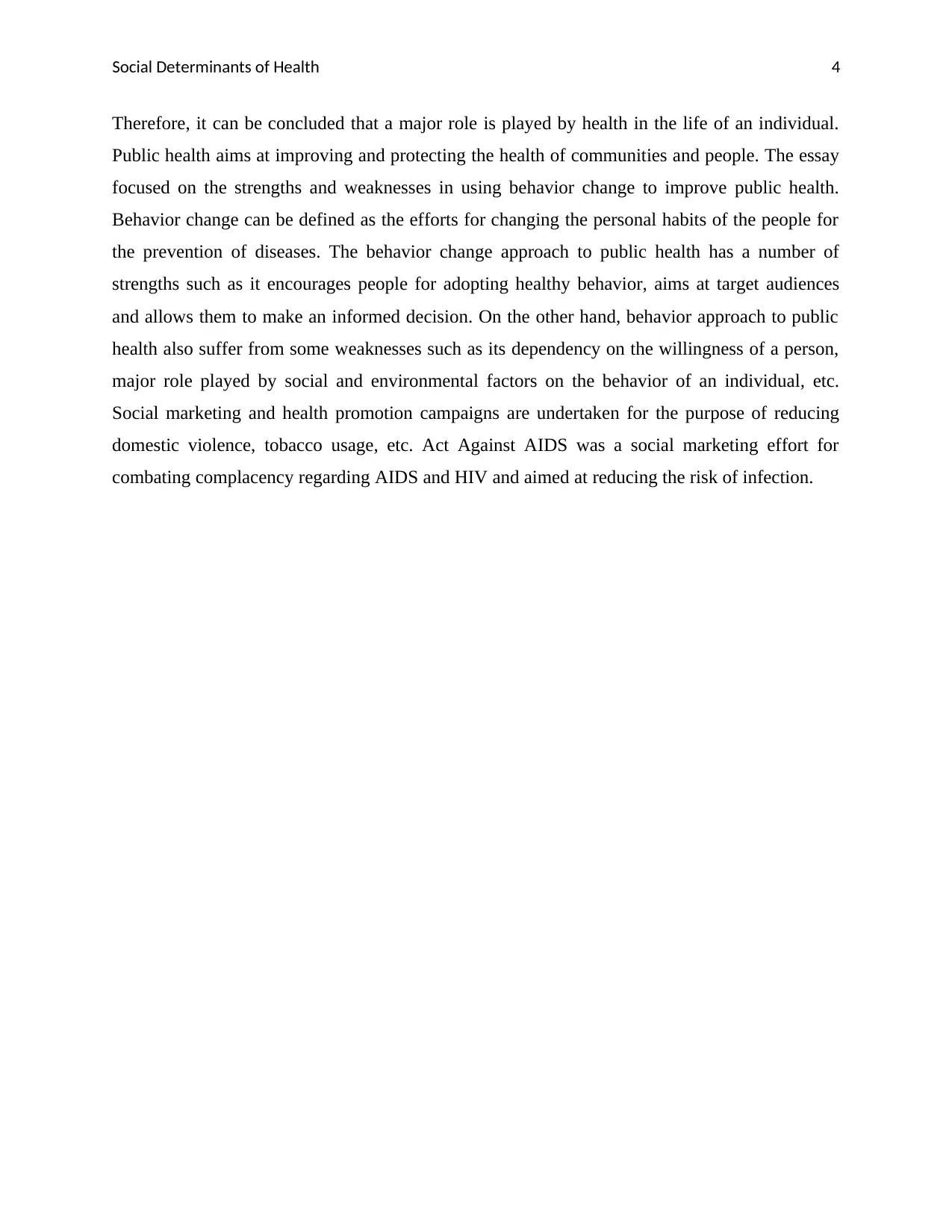
Social Determinants of Health 4
Therefore, it can be concluded that a major role is played by health in the life of an individual.
Public health aims at improving and protecting the health of communities and people. The essay
focused on the strengths and weaknesses in using behavior change to improve public health.
Behavior change can be defined as the efforts for changing the personal habits of the people for
the prevention of diseases. The behavior change approach to public health has a number of
strengths such as it encourages people for adopting healthy behavior, aims at target audiences
and allows them to make an informed decision. On the other hand, behavior approach to public
health also suffer from some weaknesses such as its dependency on the willingness of a person,
major role played by social and environmental factors on the behavior of an individual, etc.
Social marketing and health promotion campaigns are undertaken for the purpose of reducing
domestic violence, tobacco usage, etc. Act Against AIDS was a social marketing effort for
combating complacency regarding AIDS and HIV and aimed at reducing the risk of infection.
Therefore, it can be concluded that a major role is played by health in the life of an individual.
Public health aims at improving and protecting the health of communities and people. The essay
focused on the strengths and weaknesses in using behavior change to improve public health.
Behavior change can be defined as the efforts for changing the personal habits of the people for
the prevention of diseases. The behavior change approach to public health has a number of
strengths such as it encourages people for adopting healthy behavior, aims at target audiences
and allows them to make an informed decision. On the other hand, behavior approach to public
health also suffer from some weaknesses such as its dependency on the willingness of a person,
major role played by social and environmental factors on the behavior of an individual, etc.
Social marketing and health promotion campaigns are undertaken for the purpose of reducing
domestic violence, tobacco usage, etc. Act Against AIDS was a social marketing effort for
combating complacency regarding AIDS and HIV and aimed at reducing the risk of infection.
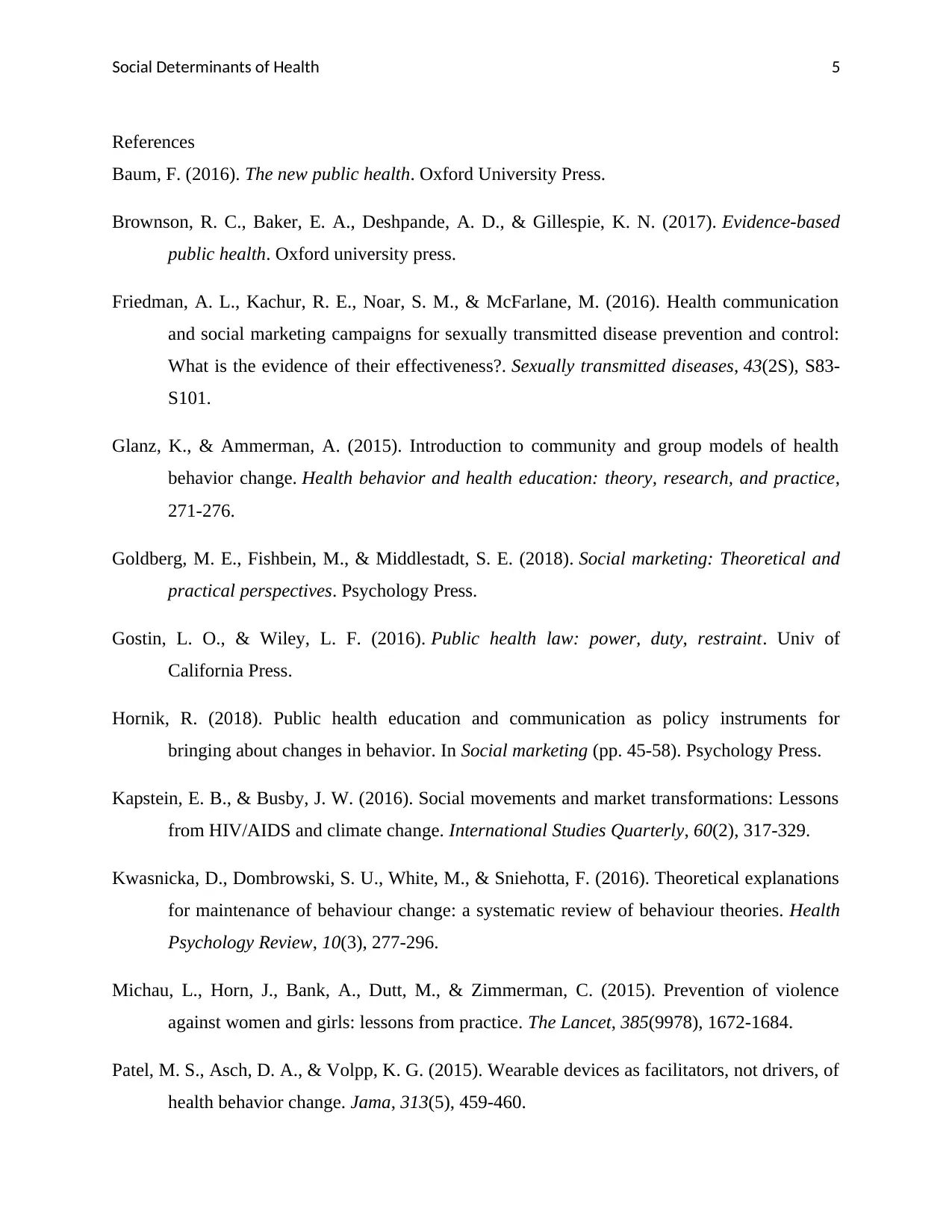
Social Determinants of Health 5
References
Baum, F. (2016). The new public health. Oxford University Press.
Brownson, R. C., Baker, E. A., Deshpande, A. D., & Gillespie, K. N. (2017). Evidence-based
public health. Oxford university press.
Friedman, A. L., Kachur, R. E., Noar, S. M., & McFarlane, M. (2016). Health communication
and social marketing campaigns for sexually transmitted disease prevention and control:
What is the evidence of their effectiveness?. Sexually transmitted diseases, 43(2S), S83-
S101.
Glanz, K., & Ammerman, A. (2015). Introduction to community and group models of health
behavior change. Health behavior and health education: theory, research, and practice,
271-276.
Goldberg, M. E., Fishbein, M., & Middlestadt, S. E. (2018). Social marketing: Theoretical and
practical perspectives. Psychology Press.
Gostin, L. O., & Wiley, L. F. (2016). Public health law: power, duty, restraint. Univ of
California Press.
Hornik, R. (2018). Public health education and communication as policy instruments for
bringing about changes in behavior. In Social marketing (pp. 45-58). Psychology Press.
Kapstein, E. B., & Busby, J. W. (2016). Social movements and market transformations: Lessons
from HIV/AIDS and climate change. International Studies Quarterly, 60(2), 317-329.
Kwasnicka, D., Dombrowski, S. U., White, M., & Sniehotta, F. (2016). Theoretical explanations
for maintenance of behaviour change: a systematic review of behaviour theories. Health
Psychology Review, 10(3), 277-296.
Michau, L., Horn, J., Bank, A., Dutt, M., & Zimmerman, C. (2015). Prevention of violence
against women and girls: lessons from practice. The Lancet, 385(9978), 1672-1684.
Patel, M. S., Asch, D. A., & Volpp, K. G. (2015). Wearable devices as facilitators, not drivers, of
health behavior change. Jama, 313(5), 459-460.
References
Baum, F. (2016). The new public health. Oxford University Press.
Brownson, R. C., Baker, E. A., Deshpande, A. D., & Gillespie, K. N. (2017). Evidence-based
public health. Oxford university press.
Friedman, A. L., Kachur, R. E., Noar, S. M., & McFarlane, M. (2016). Health communication
and social marketing campaigns for sexually transmitted disease prevention and control:
What is the evidence of their effectiveness?. Sexually transmitted diseases, 43(2S), S83-
S101.
Glanz, K., & Ammerman, A. (2015). Introduction to community and group models of health
behavior change. Health behavior and health education: theory, research, and practice,
271-276.
Goldberg, M. E., Fishbein, M., & Middlestadt, S. E. (2018). Social marketing: Theoretical and
practical perspectives. Psychology Press.
Gostin, L. O., & Wiley, L. F. (2016). Public health law: power, duty, restraint. Univ of
California Press.
Hornik, R. (2018). Public health education and communication as policy instruments for
bringing about changes in behavior. In Social marketing (pp. 45-58). Psychology Press.
Kapstein, E. B., & Busby, J. W. (2016). Social movements and market transformations: Lessons
from HIV/AIDS and climate change. International Studies Quarterly, 60(2), 317-329.
Kwasnicka, D., Dombrowski, S. U., White, M., & Sniehotta, F. (2016). Theoretical explanations
for maintenance of behaviour change: a systematic review of behaviour theories. Health
Psychology Review, 10(3), 277-296.
Michau, L., Horn, J., Bank, A., Dutt, M., & Zimmerman, C. (2015). Prevention of violence
against women and girls: lessons from practice. The Lancet, 385(9978), 1672-1684.
Patel, M. S., Asch, D. A., & Volpp, K. G. (2015). Wearable devices as facilitators, not drivers, of
health behavior change. Jama, 313(5), 459-460.
⊘ This is a preview!⊘
Do you want full access?
Subscribe today to unlock all pages.

Trusted by 1+ million students worldwide
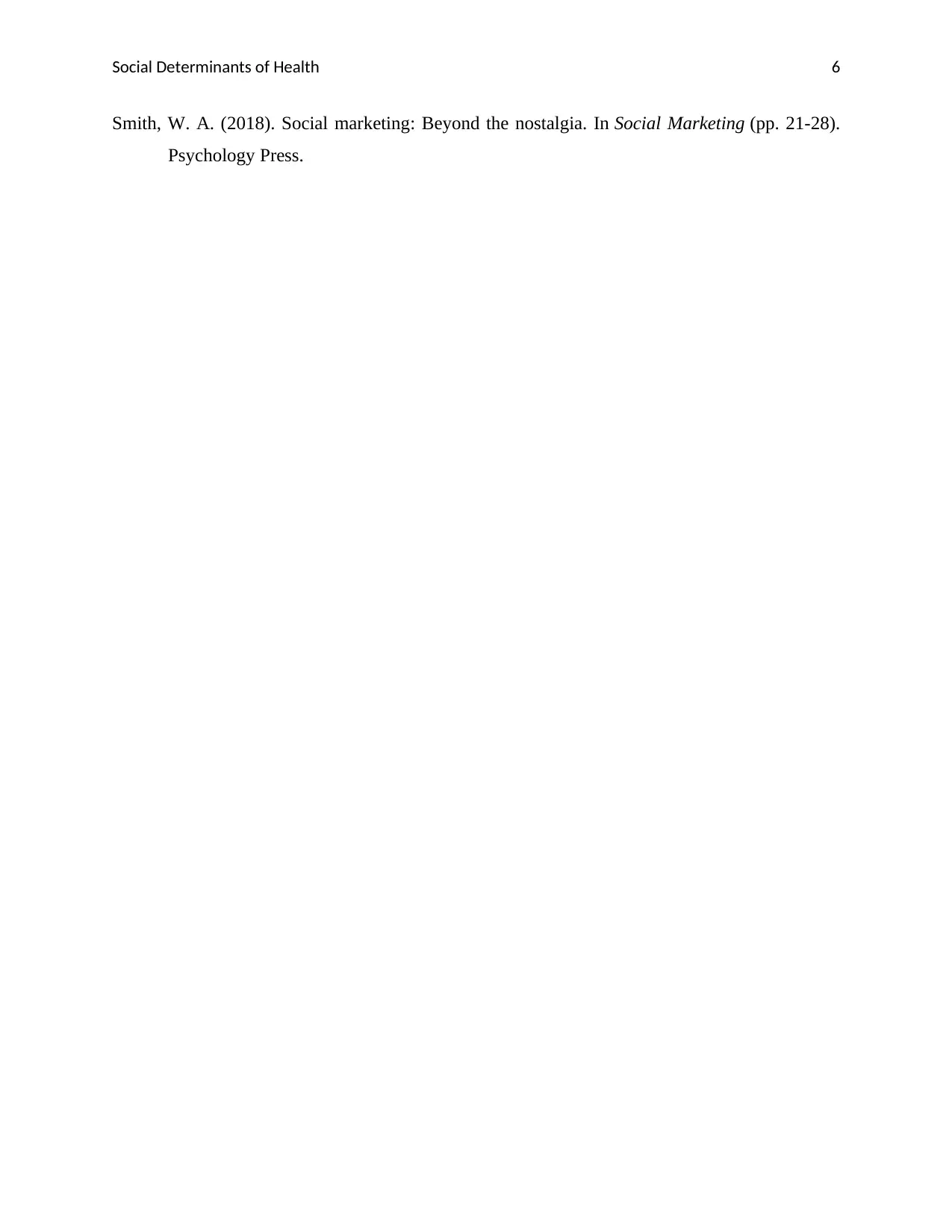
Social Determinants of Health 6
Smith, W. A. (2018). Social marketing: Beyond the nostalgia. In Social Marketing (pp. 21-28).
Psychology Press.
Smith, W. A. (2018). Social marketing: Beyond the nostalgia. In Social Marketing (pp. 21-28).
Psychology Press.
1 out of 7
Related Documents
Your All-in-One AI-Powered Toolkit for Academic Success.
+13062052269
info@desklib.com
Available 24*7 on WhatsApp / Email
![[object Object]](/_next/static/media/star-bottom.7253800d.svg)
Unlock your academic potential
Copyright © 2020–2025 A2Z Services. All Rights Reserved. Developed and managed by ZUCOL.





